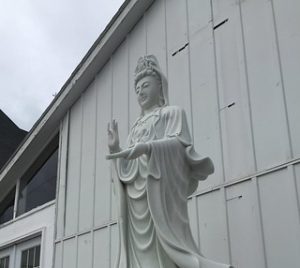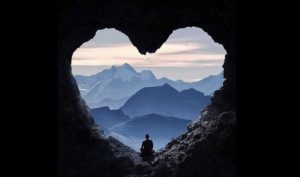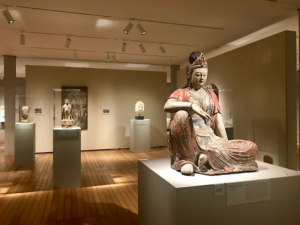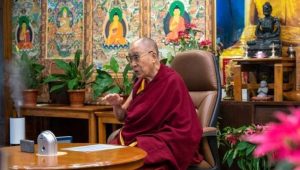
Just over a year ago, I was approached by a young Buddhist chaplain working in the Quebec prison system with a query about whether I’d publish an introduction to Buddhist practice that he’d written, in French, for his incarcerated clients. The book would be an offering of dana, with no profits for author, editor, designer, or publisher, to be funded by anonymous donors. I jumped at the chance.
Now, The Inner Path: An Introduction to Buddhist Practice for Prisoners (Sumeru Books 2024) is available for distribution to Buddhist chaplaincy programs around the world, and its French counterpart, Le sentier interieur: une introduction à la pratique bouddhiste pour les prisonniers (Sumeru Books 2025) will be available early next year. While there are obviously many books that are introductions to Buddhist practice, there are virtually none that address the specific constraints faced by prisoners. The Inner Path is unique in this regard.
Prison Dharma is not new. You may remember the movie Dhamma Brothers from 2007. And prison work by chaplains dates back much further than that. However, for the most part, that work is invisible to the world and marginalized even in Buddhist communities.
Now that Buddhist chaplaincy has evolved from a nascent presence in the North American landscape to a much more robust service leadership pathway, that growth has been nourished by increased attention to engaged Buddhist activities in the wider world, outside the paradigm of traditional Buddhist practice within Dharma centers. Typically, one thinks of chaplains in healthcare. According to the study, Mapping Buddhist Chaplains in America, published by the Chaplaincy Innovation Lab in 2021,[i] prisons, the military, or institutions of higher education comprise much smaller slices of the pie.
When one thinks of how Buddhist practice may be relevant for criminals, the story of Angulimala comes to mind. Here was a hardened serial killer reformed by the Buddha and transformed into a deeply spiritual convert who repented his evil ways. Or perhaps one recalls the story of Milarepa, whose early life was characterized by a thirst for revenge and multiple murders, but who, through Buddhist practice, reformed all of his bad karma, attained inconceivable spiritual breakthroughs, and became one of the most beloved Tibetan yogis. Indeed, we often think of the incarcerated as individuals whose evil propensities have brought them into conflict with society, and from whom we need protection. If only they could practice the Dharma, they’d become better people, the thinking goes.
While that may be the case in many instances, it is far from the whole story! Even a simple investigation into the for-profit prison-industrial complex reveals horrific systemic harm perpetrated on individuals from marginalized communities in the United States. Even something as elementary as looking into the disproportionate representation of racialized inmates in prison populations reveals serious problems with the way we understand crime and punishment. Add to that the exploitative economics of prison labor, which is sold not just to government agencies but also to many private companies who benefit from workers being paid pennies an hour.
From that perspective, who are the real criminals?
There are many arguments for prison reform.[ii] Here in Canada, we like to think our approach to prison is rehabilitation rather than punishment, and a civic service like hospitals, not for profit. There’s some validity to that, but we too have serious systemic problems. We may not get an F failing grade, but we certainly shouldn’t falsely congratulate ourselves for what is at best a D–. Consider the Swedish prison system as an example of a jurisdiction with a better track record and model for healthier outcomes.
Be that as it may, my goal here is not merely to critique our approach to criminality, but to be actively engaged in making the invisible visible, to alleviate suffering, and to support the work of others in prison outreach and reform.
As it turns out, supplying paperback books to prisoners is one well-established way of doing that. There are quite a few organizations for whom this is their sole mission, as I discovered once I had a book to offer. All I had to do to get started was to search online for “Books for Prisoners.” And requests by inmates for books on Buddhism turn out to be quite frequent, as I was told by Big House Books, a Mississippi nonprofit supplying books to inmates. I sent them 20 copies of Acharya Samaneti’s book. I’ve also sent copies to Books to Prisoners (B2P), a non-profit in British Columbia, and am working on supplying books to similar organizations in Ontario.
It’s worth noting here that many prisoners in the United States are forced to use “dedicated” tablet computers for much of their reading and interactions, at exorbitant, if not predatory, pricing per transaction. Lion’s Roar Foundation, partnering with the Edovo nonprofit,[iii] has made much of their material freely available to more than 30,000 people in US prisons on those platforms.[iv] Kudos to them!
Lion’s Roar also published an excellent article in 2018, entitled “Buddhism Behind Bars: 7 Organizations Making a Difference”[v]—another excellent resource. There are many ways for you to get involved!
Jails are often intentionally in remote locations, with visits confounded by a labyrinth of bureaucratic red tape, and resistant to public oversight. Efforts to build new facilities are often met with fierce NIMBY reaction from the communities being asked to host them.[vi] Some believe that in spite of the terrible conditions that inmates endure, they get what they deserve and those conditions are a good deterrent to further criminal behaviour. All of this makes them invisible. But, on the other hand, perhaps the invisibility of prisons is simply our lack of interest in looking.
For a bodhisattva, self and other are not two. Wisdom and compassion are not two. Just as form and emptiness are not two, the visible and invisible are not two. Those in positions of privilege on the Wheel of Life and Death are inextricably bound up with those in states of suffering. We can’t liberate ourselves without liberating them too. We can’t enter the Pure Land unless all beings do. And in this context, that includes people in prison. In fact, liberating them may be just the key to liberating ourselves from our own ego prisons.
[i] Mapping Buddhist Chaplaincy in North America (Chaplaincy Innovation Lab)
[ii] Fighting Prison & Jail Expansion (Critical Resistance)
[iv] Read “How To Build an Altar in a Cell” from The Inner Path: An Introduction to Buddhist Practice for Those in Prison (Lion’s Roar)
[v] Buddhism Behind Bars: 7 Organizations Making a Difference (Lion’s Roar)
[vi] The new Kemptville jail has been frozen for four years. Here’s why (Ottawa Citizen)
Related features from BDG
“We Have All Made Mistakes” – Teaching Mindfulness in Prisons: A Different Kind of Rehabilitation
Cuong Lu’s The Buddha in Jail: 52 Vignettes on Discovering Freedom and Happiness Within
Buddhistdoor View: Prisons and Buddhists
Buddhist Prison Chaplain: An Interview with Andrew Williams














